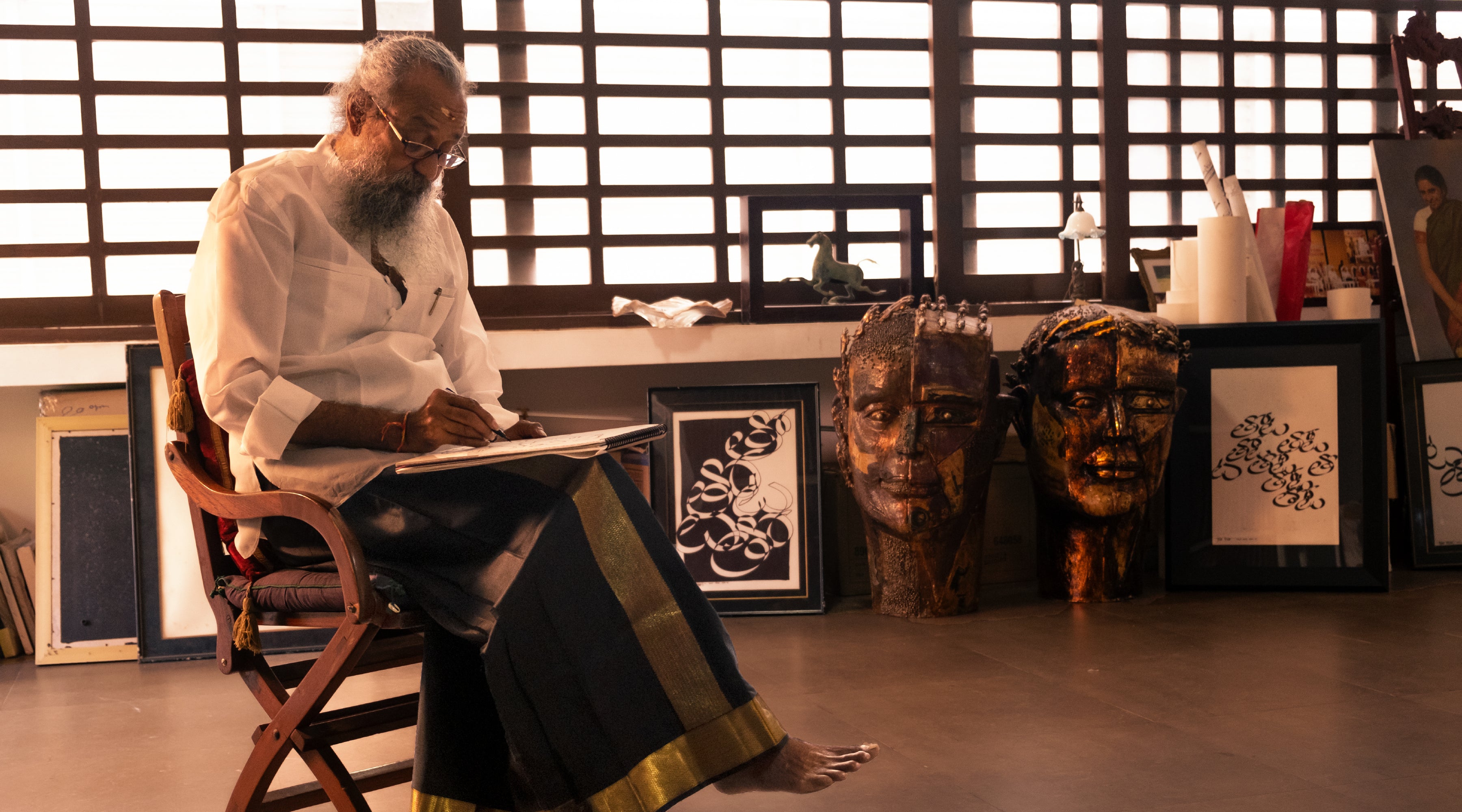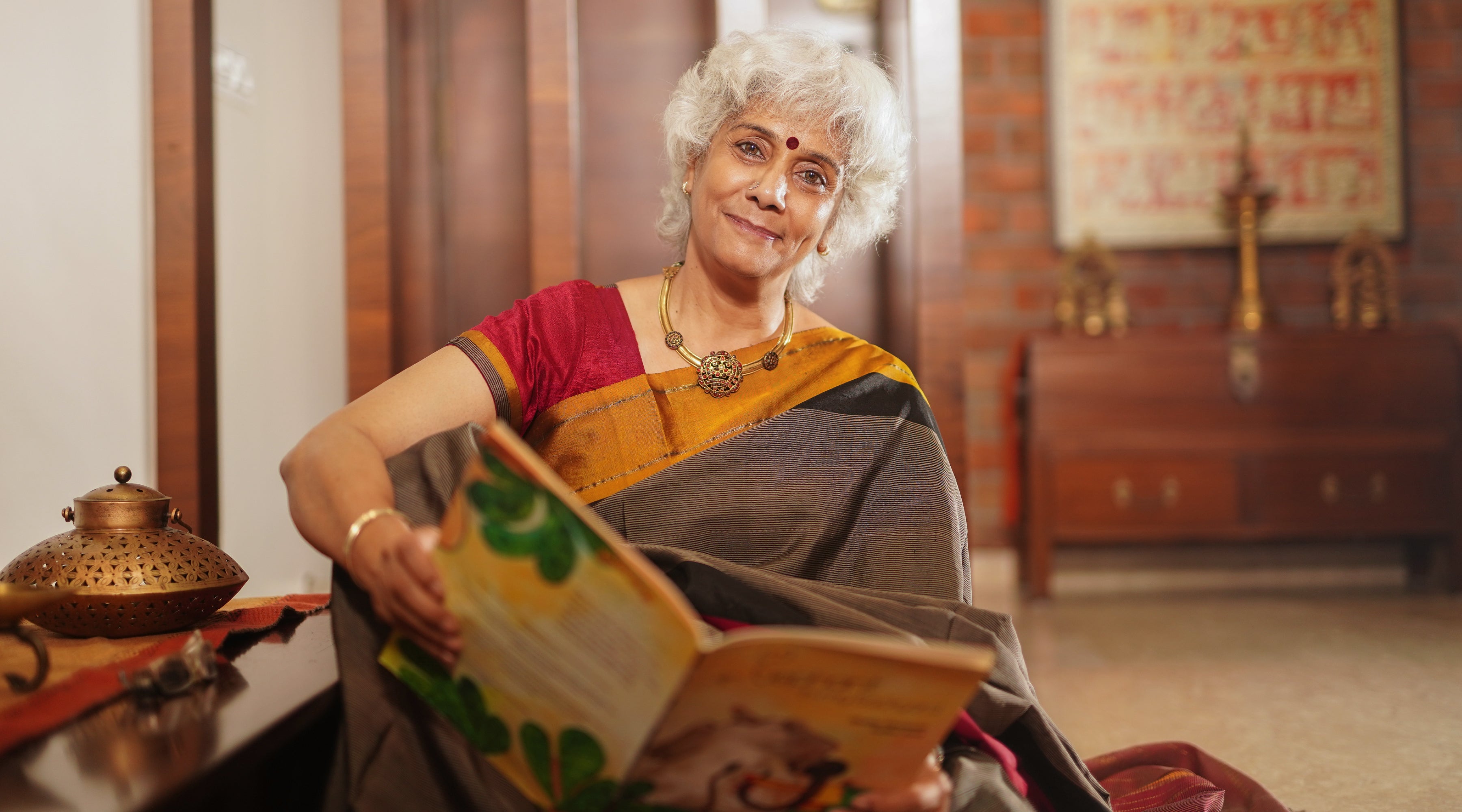KANAKAVALLI VIGNETTES : Niranjana Ramanan - A Song For All Seasons

Niranjana Ramanan, Kanakavalli’s February Vignette, is a trained Carnatic musician, a playback singer and a member of Chennai’s much-loved band Staccato. Having inherited her love for music from her father when she was just a toddler, Niranjana went on to train in the Carnatic tradition for 14 years. An unexpected entry into a music-centric reality TV show opened up an entire world of musical possibilities for Niranjana, who discovered new genres, styles and songs. Soon after, she got her break as a playback singer in the film industry, and there was no looking back. In conversation with Aneesha Bangera for The Kanakavalli Blog, Niranjana opens up about what she loves most about singing with a band, whose members become a family, and about the challenges of being a singer during the pandemic. She tells us about the highlights of her musical career, from going on tour with the maestro Ilayaraja to launching Project Delve, an initiative close to her heart that brings together the arts and artistes in unique ways. Niranjana imbibed a love for saris from her grandmother, and browses through the Kanakavalli repertoire to curate a selection weaves that reflect her deep sense of tradition. Excerpts of the conversation below...
A Song for All Seasons
What are your earliest memories of singing? What role did music play in your childhood?
My father always loved music and had a natural inclination for singing, despite no formal training. He listened to music all the time, and he sang us ragams when we were very young. By the age of three or four, my brother and I could identify these ragams and would have competitions to see who could guess them first. My father was keen that both my brother and I pursue music in some form, and so we were enrolled in Carnatic music lessons. My earliest memories of that time are of my brother eagerly attending classes while I played outside in the sand, listening to the music in the background. My brother was a much better student of music than I was back then, and I didn’t show half as much interest as he did.
A few years later, something changed—almost like a switch—and I decided to get more serious about music. Almost at the same time, my brother’s interest began to wane. Still, nobody in my family thought it would be a career, and in fact it was not a choice they encouraged. Lucky for me, they have now changed their minds and are incredibly supportive of my music.

Above (Clockwise from top left): Niranjana as a child with her brother; All Niranjana's earliest memories of music involve her brother; Niranjana with her mum whose smile she inherited; With her parents who are great supporters of her musical career.
I was very fortunate to be in a school that gave me numerous opportunities to sing. I made my debut as a playback singer (of sorts!) when I was in the third grade. The legendary Ilayaraja and MS Viswanathan were collaborating on an album—something that never happened again—and they came to our school to audition for child voices. I’ll never forget recording at Prasad Studios and receiving my very first payment as a musician—a grand sum of 600 rupees! This was my first studio experience and one I won’t forget. That particular song and composition is etched in my mind. Years later, when I had the chance to go on tour with Ilayaraja, I felt so blessed to be able to go up and sing that same song for him.
Right through school, I attended musical events. I remember, in particular, this series of bhajan competitions that was like Chennai’s own Battle of the Bands! It was a big deal back then, and we all thoroughly enjoyed ourselves. From the 5th grade until I finished school I was very involved in the music scene, and even after I graduated, I was often invited back to perform, train younger students or judge competitions. These experiences were very valuable and made me start thinking about the possibility of pursuing a serious career in music.
Tell us a little about your early years in the industry. How did you get your first break as a playback singer?
After school, I decided to start training as a Chartered Accountant, so I wasn’t enrolled in a conventional college. It was during this time that I got the chance to participate in a reality show that completely changed the course of my career.
Up until this point, my exposure to music was largely Carnatic—I had trained for 14 years in this style. My father was opposed to us listening to any other music, especially to film and pop songs, so my brother and I didn’t own a single cassette or CD. When I got into the Super Singer TV show, it was like an entire horizon of music opened up before me. I felt like a kid in a toy store. Almost every song I heard on the show was new to me, and almost every song that I sang was something I had never sung before in my life! I remember that my co-contestants couldn’t believe this and would often make fun of me. It wasn’t easy to make people understand that this music they had taken for granted was just not part of my childhood.

Above (left to right): Niranjana with KS Chithra just before a concert in Connecticut, where Niranjana had a chance to perform the singer's hit song 'Rum Bum Bum'; With the maestro Ilayaraja, a constant source of inspiration.
I had great fun on the show, and I think I took it in the right spirit. With only the most minimal knowledge of musical styles other than Carnatic, and with only some basic help, I managed to make my way in the competition. While this was challenging, it was also really exciting. I didn’t let anything hold me back, and every song I picked was an experiment. I made it to the top 10, but I suspect that I have found a different kind of success than anyone expected. Since then, I have been able to carve my own path, deciding exactly what I wanted to do, and how I wanted to position myself as a singer.
Soon after, I got my first playback opportunity as an adult. I was at a chorus session for the music director D. Imman. The team wanted the track the very next day for a shoot and Imman asked me to sing a scratch. He loved my take on the song and retained it as the final voice. That was my first real break into the world of cinema.
What do you love most about singing with your band Staccato? How would you describe the band's musical style?
Despite my growing career in the film industry, I was very clear that I wanted to create a brand and do something different. That’s when I joined the band Staccato, back in 2013. I have always loved the idea of being in a band, and joining one has truly lived up to my expectations. As a band, you travel like a family, you have to be there for one another, and you have to be totally in sync in everything you do on stage.

Above: Niranjana with her band 'Staccato'; A poster of the band whose members bring a variety of influences and backgrounds to their sound; Niranjana and her bandmates taking a time out after back-to-back concerts.
I was fortunate that my ideas and inclinations coincided with those of the rest of the band. Every member of Staccato comes from a different background, with different musical experiences and interests. We have a percussionist from Dehradun who plays a variety of traditional Indian instruments in addition to the tabla, from the pakhawaj to the dhol and khol. These lend unique sounds to our music, allowing us to expand the horizons of our listeners. The lead singers—Gautam and I—both have typical Carnatic influences with many years of singing in the film industry under our belts. The keyboardist and guitarist both have Western classical training, while our bassist has very different musical influences that are rooted in the Tamil film industry. In a sense, the classical styles hold us together as a band, allowing us to branch out in various directions, experimenting with genres and original compositions. Singing with Staccato has been the most wonderful and fulfilling experience.
I also wanted to explore new possibilities with music, and that’s why I created my own banner, Project Delve, under which I try to bring together artistes and the arts. Through this project I seek to create a visual experience of Carnatic music, weaving together music with dance and cinematography, all set against the backdrops of beautiful locations. The idea is to express a range of traditional Carnatic songs through movement, dance and top-notch visuals.
What has been the highlight of your musical career so far?
Launching Project Delve was definitely one of the highlights of my career and my life so far. Our debut track, Maathey, reached a wide audience and also hit a million views organically on YouTube which was very exciting.
Another highlight was being selected to go on tour with the maestro Ilayaraja for a series of live concerts in the US, Australia and Singapore. I attended a day-long chorus session that he held to pick voices to travel with him. At lunchtime, when everyone usually unwinds and takes a break, he asked us to sing one by one. There was a general sense of nervousness with everyone wondering what to sing, and whether to sing one of Ilayaraja’s own songs. We were all dreading going inside the room, but I did some quick thinking. I sang an Ilayaraja song from a film, but it was an entirely Carnatic composition, so it played to my strengths. It was a six-minute Ragamalika song, and after I sang an excerpt, I remember that he asked me why I’d stopped and told me to continue singing. From that batch, he picked a few of us, and after that there was no looking back. We had two months of rehearsals to learn 120 songs and then went on tour for one month. Every single day on stage was a day of immense learning for me. That experience contributed a great deal to who I am today as a person and a singer.

Above (clockwise from top left): Niranjana in concert, doing what she does best; Performing with the legendary playback singers KS Chithra and Mano live in concert in Singapore; A stage rehearsal of Ilayaraja's concert in Singapore; All smiles on stage.
How has the pandemic changed the way you and your band sing and perform?
When Covid-19 hit us in early 2020, we all spent four or five months at home not quite knowing what was going on. Our shows were being cancelled week after week, from weddings to club and corporate events. Finally, after five months of all of us sitting in our individual homes, we decided we needed a plan. We realised that we had to use this time to work on something so that when things improved and the industry was back on its feet, we would be ready.
We started a project called Freshly Brewed in which Staccato collaborated with the El Fe choir, which consists of ten beautiful voices. The idea was born purely out of the circumstances we found ourselves in. We realised that we didn’t have the time or ability to work on own compositions while we were in lockdown, and so we started practicing a series of covers. We ended up recording seven tracks, all live and all in one day. The experience of recording live, capturing our mistakes and our moods, was amazing. We were very lucky that when things did open we were able to perform as Freshly Brewed with our extended band, and have done four or five shows, travelling with this concept.

Above (left to right): Niranjana in her element on stage; Staccato's 'Freshly Brewed' after a concert in Bangalore.
This experience of surviving the pandemic as a band has been both challenging and rewarding, and now as we go through another wave, we’re staying positive and waiting to get back to singing on stage.
What are your top five favourite songs of all time?
There are too many to name, but I’ll tell you my current favourites:
Maathey – Niranjana Ramanan, Project Delve - watch here
Indian Rain – Colonial Cousins - watch here
Nahin Saamney Tu – Hariharan & A.R. Rahman - watch here
Om Namaha – SPB & Janaki - listen here
Easy On Me – Adele - watch here
Who are your favourite artistes?
There are far too many to name! I think I have something to learn from every artiste I listen to.
Whose would you say is a voice to watch out for in the South Indian film industry?
Sukanya Varadarajan
How do you define beauty and tradition?
Ever since I was in school, I observed girls being categorised as pretty or not pretty. Even at that age I truly believed that every single person was beautiful in their own way. I think beauty is both subjective and personal, but most importantly, beauty is for everyone. We should never differentiate with respect to beauty. Tradition is what roots us, bringing us back to our ancestors. My grandmother is my biggest role model, from the way she drapes her saris to her phenomenal collection of saris. I think that tradition brings me closer to her.

What does the sari mean to you?
My love for the sari comes from my paati. I grew up watching her wearing her saris so beautifully and caring for them with such love. I’m currently in the process of moving away from fast fashion and trying to wear more saris in my everyday life, something I am thoroughly enjoying.

Above (left to right): Niranjana as a child with her grandmother, who inspired her love for saris; Niranjana always admired her grandmother's beautiful sari collection and the way she cared for them.
We have had two weddings in the family recently—my brother’s and mine—and we really picked our saris with care. We all believe that every sari is an heirloom. I want to be able to pass my saris on to my daughter, for her to cherish and pass on to her own daughters. My mother, grandmother, aunt and I shopped at Kanakavalli with this in mind, knowing that the kanjivaram is rooted in tradition. Every mayil chakaram, every annam, every motif and colour, will get passed on. And this entire experience is made more beautiful with Kanakavalli.


Above (Clockwise from top left): Niranjana and her husband; Dressed in one of her favourite saris; A shot of Niranjana dressed in Kanakavalli for her wedding; Niranjana is trying to wear more saris and move away from fast fashion.
What’s the story behind the Kanakavalli sari you’ve chosen to wear for the Vignettes feature?
My mother wore this beautiful kanjivaram with kattams, annams and chakarams for my wedding. We picked the sari within a few minuts of going to the store, and it is one of my favourites.

Niranjana is wearing a gorgeous kanjivaram with checks in orange, green and ruby red, shot with crimson and enclosing peacocks and chakarams in zari. The ruby red borders feature geometric and paisley patterns with a selvedge in green, while peacocks adorn the pallu.
- Niranjana Ramanan, in conversation with Aneesha Bangera, photography by Raghuram Vedant.
View Niranjana's accompanying guest curation here.



